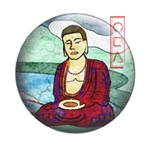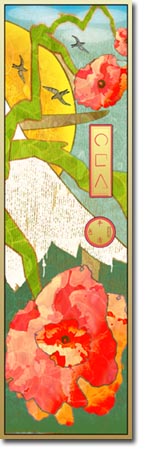On The Way: The Daily Zen Journal
King of Samadhis
Dogen (1200-1253)
To transcend the world directly, to manifest the magnificence of the buddha ancestor’s house-this is sitting in the meditation posture. To leap over the heads of outsiders and demons, and become a true person inside the buddha ancestor’s room-this is sitting in the meditation posture. To sit in the meditation posture is to transcend the deepest and most intimate teaching of the buddha ancestors. Thus, buddha ancestors practice this way without needing to do anything else.
Know that the world of sitting practice is far different from other worlds. Clarify this for yourself, then activate the way-seeking mind, practice, enlightenment, and nirvana of the buddha ancestors. Study the world at the very moment of sitting. Is it vertical or horizontal? At the very moment of sitting, what is sitting? Is it an acrobat’s graceful somersault or the rapid darting of a fish? Is it thinking or not thinking? Is it doing or not doing? Is it sitting within sitting? Is it sitting within body-mind? Is it sitting letting go of sitting within sitting, or letting go of sitting within body-mind? Investigate this in every possible way. Sit in the body’s meditation posture. Sit in the mind’s meditation posture. Sit in the meditation posture of letting go of body-mind.
Rujing, my late master, Old Buddha, said, “Practicing Zen is letting go of body and mind. It can only be done by wholeheartedly sitting; incense offering, bowing, chanting Buddha’s name, repentance, and sutra reading are not pivotal.”
My late master is the only one in four or five hundred years who has plucked out the eye of the buddha ancestors, and sat down inside that eye. There are few in China who can stand shoulder to shoulder with him. Perhaps, there are some who have understood that sitting is buddha-dharma and buddha-dharma is sitting. But there is no one else who has personally experienced that sitting is sitting, and so there is no one else who upholds buddha-dharma as buddha-dharma.
Thus, there is sitting with the mind, which is not the same as sitting with the body. There is sitting with the body, which is not the same as sitting with the mind. There is sitting letting go of body-mind, which is not the same as sitting letting go of body-mind. To get to this place is to be immersed in the practice and understanding of the buddha ancestors. Maintain this insight. Investigate this awareness.
Shakyamuni Buddha said to the assembly, “When you sit in the meditation posture, you realize samadhi in body and mind, and give rise to an awesome virtue that people respect. Like the sun illuminating and refreshing the world, this sitting removes obscurities from the mind and lightens the body so that exhaustion is set aside. Enlightenment becomes as natural as a dragon curled up at rest. A demon is frightened even by a picture of someone sitting in the meditation posture; how much more so by a living person who realizes the way sitting motionless and at ease.” So, we know that the merit of such sitting is immeasurable. This ordinary everyday sitting is itself boundless joy.

Shakyamuni Buddha continued speaking to the assembly, “Therefore, you should sit in the meditation posture.”
Then the Tathagata, the World-honored One, taught his disciples how to sit and said to them, “Some outsiders try to practice by standing on tiptoes, others by standing continuously, and still others by adopting the yogic posture of hooking their feet over their shoulders. These people develop unbalanced minds that founder in an ocean of delusion because their postures are unnatural. Why do I teach my disciples to sit up straight in the meditation posture?
“Because it is easy to regulate the mind when the body is upright. If the body is straight, the mind is not dull. Instead, the mind is forthright, the intention is true, and mindfulness is present. If the mind scatters or the body leans, gather together your body-mind and resume the upright posture. If you want to manifest samadhi and enter it, you should gather together all distracted thought and scattered mind within this posture. Practice in this way and you will manifest and intimately enter the king of samadhis.”
Thus, we clearly know that sitting in the meditation posture is itself the king of samadhis. It is itself manifesting and intimately entering. All other samadhis serve the king of samadhis.
Sitting in the meditation posture is a forthright body, a forthright mind, a forthright body-mind, a forthright buddha-ancestor, a forthright practice-realization, a forthright top of the head, and a forthright life stream. When you sit in the meditation posture, the skin, flesh, bones, and marrow of a human being are immediately vivid in the king of samadhis. The World Honored One taught humans and devas how to sit in this meditation posture. It is the mind seal correctly transmitted by the Seven Original Buddhas.
Shakyamuni Buddha sat in this meditation posture under the bodhi tree for fifty small eons, sixty great eons, and innumerable unclassifiable eons. Perhaps he sat for three weeks, or maybe for only a few hours. In any case, the Buddha’s zazen is the turning of the wondrous wheel of dharma; in it is contained his lifetime guidance. Nothing is lacking. The yellow scrolls and red rolls of the sutras are all here. In this moment of sitting, buddha sees buddha and all beings attain buddhahood.
Soon after Bodhidharma, the First Chinese Ancestor, arrived from India, he sat zazen, facing the wall in the meditation posture for nine years at the Shaolin Temple, Shaoshi Peak of Mt. Song. Since then, the head and eyeball of his practice have prevailed all over China. Bodhidharma’s life stream is just this sitting in the meditation posture. Before he came from India, people in China had not truly known sitting in the meditation posture. But after he arrived, they came to know it. Thus, for one lifetime, for myriad lifetimes, from head to toe, without leaving the monastery and without concern for other activities, wholeheartedly sit in the meditation posture day and night- this is the king of samadhis.
Presented to the assembly of Yoshimine Temple in 1244
Dogen (1200-1253)
Excerpted from Beyond Thinking – A guide to Zen Meditation Edited by Kazuaki Tanahashi




Most of what we have read or heard about sitting meditation has come from contemporary vehicles for Buddhism. This lovely piece, King of Samadhis, helps communicate the direct teaching of sitting meditation expounded hundreds of years ago to monks in Dogen’s assembly.
Within this short piece we are encouraged to investigate for ourselves what sitting is and isn’t. There are questions to explore, but there is also a very clear explanation of the value of the posture itself and the process.
We are next connected to Dogen’s own teacher, Ruling, and his own words on sitting meditation. There is a deep sense of continuity established between our own meager attempts at sitting and the long line of those who have gone before us, sitting in the same posture, with the same intent. Beginners and Zen masters alike are all sitting in the same posture.
“The primary point of awareness for those who practice the way is to be free from the idea of the self. To be free from the idea of the self means not to be attached to the self. Without being free from self, the way of buddha ancestors cannot be attained, even if you master the words of ancient teachers and continue sitting like iron or stone for a thousand lifetimes in myriad eons. Further, mastering the expedient and complete teachings or exoteric and esoteric teachings without being free from attachment to the self would be like counting another’s wealth without owning half a penny for oneself.”
Dogen from Informal Talks
Then the words from Shakyamuni himself affirms sitting practice as the core of the path to enlightenment; it is the very process he transmitted to his disciples and to us generations later.
Ending with Bodhidharma and his commitment to sitting, we come full circle to experience the richness of practice, the depth of our sitting and the many others who join us each day. The next time we wonder why we are sitting, recall how many have gone before us into the unknown asking the same timeless questions and join the fearless explorers who just never gave up. We too are part of this timeless tradition.
Still exploring,
Elana, Scribe for Daily Zen